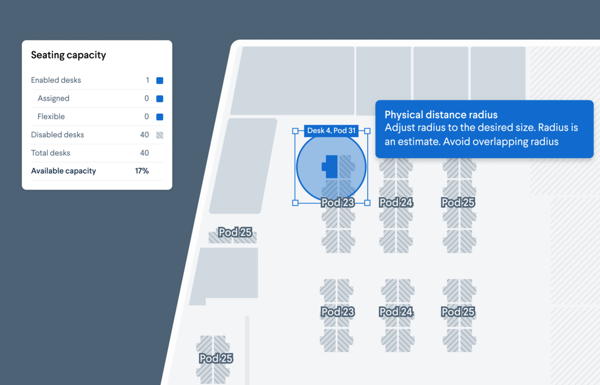Now that many industry leaders have announced their strategies for transitioning employees out of their home offices and back to work, other organizations are following suit and creating their own return to work policies. Companies like Ford have revealed their lengthy return to work plans whereas businesses like Google and Facebook have recently announced that they're extending their work from home policies until 2021.
Regardless of when you make the return to your office, precautions will be taken and a new way of "business as usual" will go into effect. After considering their state and local ordinances, as well as the ever-changing federal regulations, companies can begin to reopen while prioritizing the safety of their employees.
How to Prepare Your Office for the Return to Work
1. Staggered and Partial Return to the Office
Once you align with government guidelines and it's safe and necessary to begin returning employees to on-site work, approach the return wisely. The return to work shouldn't be an all-or-nothing approach, but rather a partial return to integrate distancing in the office. The first step is to gauge your employees' comfort with returning to the office.
When employees are comfortable returning to the office, integrate a staggered return plan. For example, on Monday and Wednesday, everyone with a name that starts with a letter in the first half of the alphabet goes into the office, and on Tuesday and Thursday, the other half of the alphabet can go in.
With this approach, you can begin returning to work while being mindful of maintaining physical distance between people. If you have teams that may benefit from working together, you can do a team-based approach and strategically think through who would be the best groups to come in each day.
2. Desk and Seating Spacing
Now that your employees have made a staggered return to the office, their in-office health is the priority. For returning workers that are unable to work from behind closed office doors, desks should be moved to six feet apart to minimize the possibility of contact. For open office plans, employees should space their seating arrangements to leave ample room between themselves and their coworkers.

Source: Robin
3. Only Open Necessary Areas
Returning to the office doesn't mean a return to all aspects of office life. During this return to work process, only the necessary areas of the office should be opened. Break rooms, on-site fitness centers, cafeterias, and conference rooms should not be reopened unless absolutely necessary. If they are reopened, they should be opened with the proper precautions. For example, large cafeterias and conference rooms should only be used by a few people at a time and only if they remain at a distance throughout the use and sanitize the space afterward.
In cafeterias, use tape or stickers on the floor to mark six feet of distance in the line. Only offer individually packaged food items in communal areas, and stay away from things like open salad bars and self-serve stations. Convert your hot foods bar to a counter where an employee wearing gloves and a mask can serve staff members.
4. Enable Virtual Collaboration
Before requiring employees return to the office, take stock of how your teams are handling their remote work lifestyle. Maybe some teams are thriving while collaborating virtually and are in no rush to return to the office. There's no need to force a return to the office.
If working remotely works for your team, keep it virtual. For large meetings that would typically take place in a conference room, utilize virtual meeting software like the Meeting Owl to best replicate that face to face meeting experience.
5. Signage and hand washing
To instill a sense of order in the workplace, take the opportunity to create signage that demonstrates your new order of business. The more signage you use to direct your employees, the less guessing and assuming of protocol that will happen. This signage could include:
- Directing traffic flow in hallways and stairwells
- Clearly marking sanitizing stations
- Desk maps to guide workspace distancing
- Floor graphics to support social distancing
- Signs to promote hygiene best practices
6. Consistent sanitization and nightly cleaning
Throughout the day, employees should be expected to wash or sanitize their hands regularly. Additionally, to support a staggered return to work schedule, all work stations will be thoroughly sanitized at the end of each workday. All community utilities, such as door handles and bathroom, will be sanitized after each individual use, and office managers will schedule more professional deep cleansing during the week.
Encourage employees to keep personal items on desks to a minimum, but ensure they have the desk equipment they need to do their jobs effectively. Keeping desks clear will help environmental services staff to sanitize effectively and limit the number of surfaces that could play host for bacteria and viruses.
7. HVAC Air Purification Systems
When transitioning from remote work back to on-site operations, the biggest structural change could be the installation of sophisticated air filtration devices such as HVAC air purification systems. For offices operating on a limited budget, requiring all employees to wear masks while at work may be a more realistic choice. But for large companies without a budget restriction, investing in a long term air filtration system is a good bet.
Before the modern workforce felt the strength of COVID-19, it was already leaning toward the hybrid sphere. This shift back to on-site work will be slow and come with many new adaptations and regulations along the way. As you continue your hybrid work lifestyle, remember that working remotely doesn't mean being less productive. For hybrid team best practices, here is everything you need to know.
%20(1).png)
Better meetings start here
From huddle rooms to boardrooms and everything in between, we’ve got you covered with solutions that take teamwork to the next level.
Shop Solutions